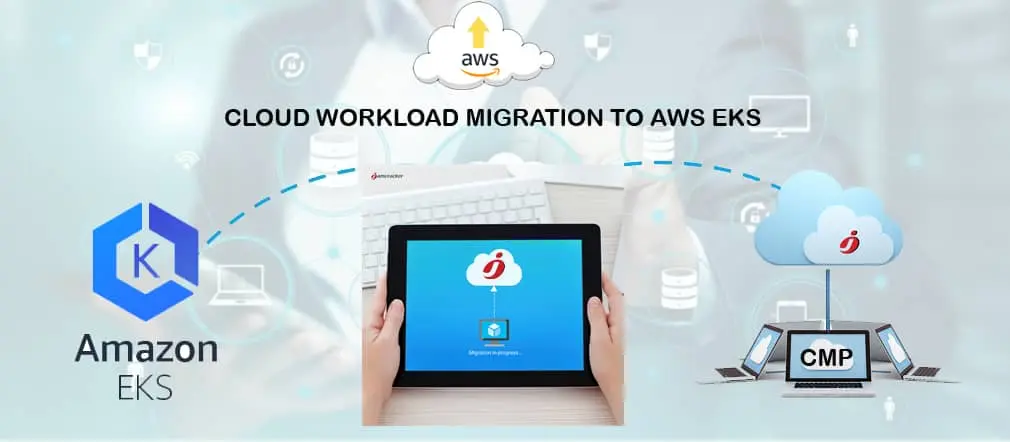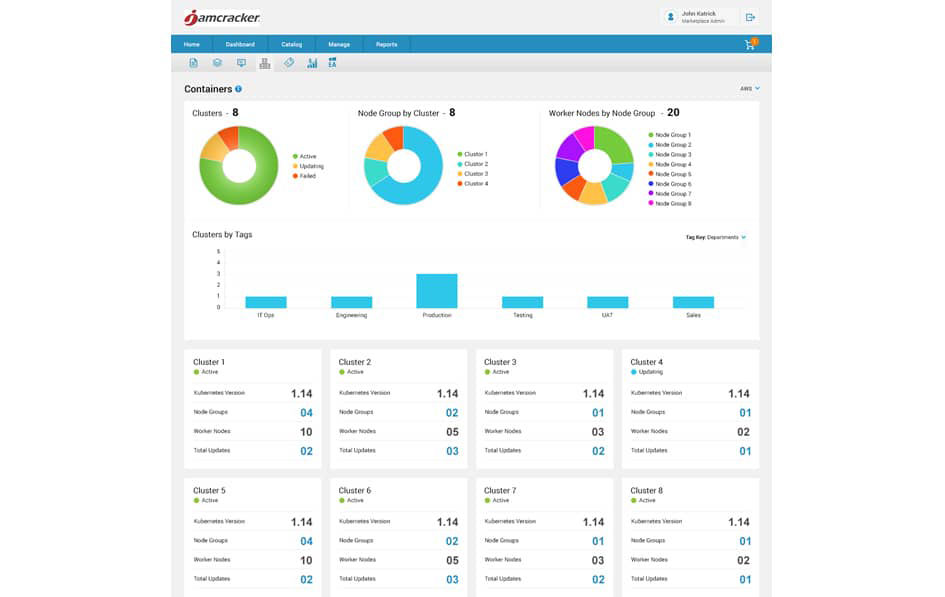Many businesses are embracing the agility and scalability of cloud computing, with AWS EKS (Elastic Kubernetes Service) emerging as a popular choice for container orchestration. However, migrating workloads from existing platforms like ECS (Elastic Container Service) to AWS EKS can be a complex undertaking.
This article dives into the challenges associated with AWS EKS migration and explores how Jamcracker Cloud Management Platform (CMP) can simplify the process.

Challenges of Migrating to AWS EKS
- Complexity of EKS vs. ECS: While both services manage containers, EKS requires more manual configuration compared to the managed service approach of ECS.
- Heterogeneous Environments: Migrating from diverse on-premise or cloud environments introduces compatibility challenges.
- Database and Image Migration: Transferring databases and container images to compatible AWS services requires careful planning and execution.
- Security Considerations: Ensuring robust security measures throughout the migration process is crucial.
How Jamcracker CMP Simplifies EKS Migration
Jamcracker CMP streamlines the migration journey by offering a comprehensive suite of tools and automation features. Here's how it empowers a smoother transition:
Let’s understand with the help of a use case:
You have IT assets (infrastructure & application) hosted in your datacentre having VMware vCenter environment and planning to move them to AWS EKS (Elastic Kubernetes Service) Jamcracker platform has done full automation of all the steps.
1. AWS Account Creation - If you are already using the Jamcracker Cloud Management Platform and subscribe to AWS service, no change or additional environment configuration needed. If you don’t have an AWS account, the Jamcracker platform can create one.
2. Provision EKS Cluster - Creation of EKS cluster and making it application migration ready. Let’s look at automation steps in detail which are part of the orchestration plan.
i. Creation of Bastion Host under VPC, this is used for the Amazon EKS (Elastic Kubernetes Service) Deployment and also for the Kubernetes Deployments
ii. Creates Nodegroup and Worker Nodes
iii. Creates VPC, Private Subnet & Public Subnet
iv. Creates NAT Gateway with Elastic IP
v. Replication in multiple availability zones
vi. Creation of Auto-scaler group
vii. Enable container insights/Cloud watch for the Amazon EKS cluster
viii. Setup of the Amazon Elastic Block Store (EBS) CSI driver.
ix. Setup of the Amazon EFS CSI driver.
3. Provision & Migration of Database - It starts with the provisioning of Amazon RDS database service and start database migration from on-premise to AWS RDS. Migration automation gives the flexibility to define database migration ways. You can define either direct connectivity or use tools like CloudEndure.
4. Migrating Container Images - Migration automation gives the flexibility to define container image migration ways. It supports moving images from container registry used on-premise to Amazon Elastic Container Registry (ECR) or users can provide direct access to container registry used at on-premise environment.
5. Deploying Application & Connecting RDS - Once set-up is done successfully users can launch the application to the AWS EKS environment and connect the application to RDS using Jamcracker DevOps automation feature.
6. Container Dashboard - Post successful migration, your container environment can be view and monitor via Container Dashboard. You can monitor Clusters, Nodegroups, and worker nodes

AWS EKS Dashboard
After migrating to AWS you can have a full track of your cost visibility along with IT governance.
Migrating workloads to AWS EKS opens doors to enhanced scalability and agility. By leveraging Jamcracker CMP's automation capabilities and migration expertise, you can navigate the process with confidence.
Frequently Asked Questions (FAQs)
What is AWS EKS?
AWS Elastic Kubernetes Service (EKS) is a managed Kubernetes service that simplifies deploying, managing, and scaling containerized applications using Kubernetes on AWS.
Why migrate to AWS EKS from ECS or on-prem environments?
Organizations migrate to AWS EKS to gain enhanced scalability, flexibility, and control over their containerized applications compared to ECS or legacy infrastructure.
What challenges are involved in migrating to AWS EKS?
Common challenges include managing the complexity of Kubernetes, configuring networking and infrastructure, migrating databases and container images, and ensuring robust security throughout the process.
How does Jamcracker CMP help with AWS EKS migration?
Jamcracker Cloud Management Platform simplifies EKS migration through full automation of cluster provisioning, database and image migration, application deployment, and monitoring via a centralized dashboard.
What infrastructure components does Jamcracker CMP automate during EKS cluster setup?
Jamcracker CMP automates the creation of Bastion Hosts, Nodegroups, VPCs, Subnets, NAT Gateways, Auto-scaler groups, monitoring tools (CloudWatch), and drivers for EBS and EFS.
How is database migration handled in this solution?
Jamcracker CMP provisions Amazon RDS and enables database migration from on-premise environments using direct connectivity or third-party tools like CloudEndure.
How are container images migrated to AWS?
The platform supports migrating container images from on-premise registries to Amazon ECR or accessing existing registries directly for seamless image transfer.
What happens after the application is deployed to AWS EKS?
After deployment, Jamcracker CMP connects the application to the database (RDS) and enables monitoring through its Container Dashboard, where users can track clusters, nodes, and workloads.
Does Jamcracker CMP provide visibility into costs and governance after migration?
Yes, the platform offers full cost visibility and governance controls post-migration to ensure efficient cloud operations and budget management.